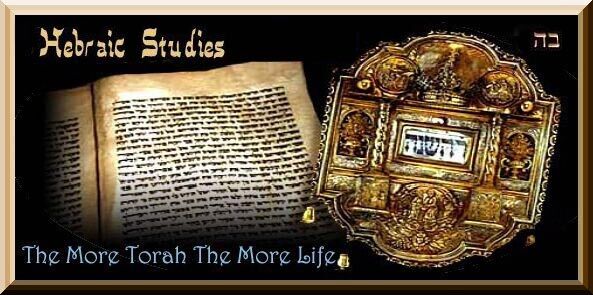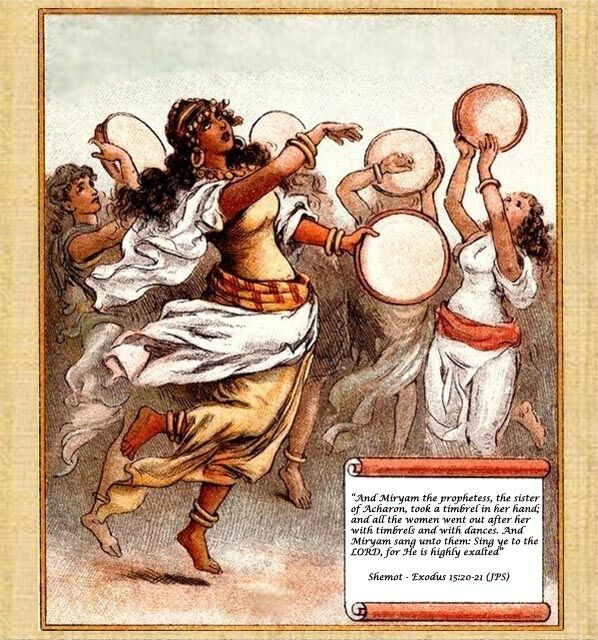
Hebraic Studies - Miryam - Miriam's Song of the Sea

Please
do NOT visit this site on Shabbat or on a
![]() - Y-H-V-H, which
we usually pronounce as “Adonai” or “HaShem”.
- Y-H-V-H, which
we usually pronounce as “Adonai” or “HaShem”.
*“This
is My Name forever, and this is My memorial to all generations.”
Shemot - Exodus 3:15.
Although some minor alterations have been made relating to names and attributes having been corrected.
Please Note:
Verse numbers may at times vary in non Jewish Bibles.

Shemot -
Exodus chapter 15 verse 1 & verses 21 & 21.
With Rabbi Reuven Ben-Avraham.
“Then sang Moshe - Moses and the
B’Nei Israel this song unto ![]() , and spoke, saying: I will sing
unto
, and spoke, saying: I will sing
unto ![]() , for He is highly exalted; the horse and his
rider hath He thrown into the sea” Shemot - Exodus 15:1 (based
on the ‘Jewish Publication Society’ [JPS] of the
Torah).
, for He is highly exalted; the horse and his
rider hath He thrown into the sea” Shemot - Exodus 15:1 (based
on the ‘Jewish Publication Society’ [JPS] of the
Torah).
![]() - Miriam, leading the women, sang as well:
- Miriam, leading the women, sang as well:
“And Miryam the prophetess, the sister of
Acharon - Aaron, took a timbrel in her hand; and all the women
went out after her with timbrels and with dances. And Miryam sang
unto them: Sing ye to ![]() , for He is highly exalted: the
horse and his rider hath He thrown into the sea” Shemot
- Exodus 15:20-21 (JPS).
, for He is highly exalted: the
horse and his rider hath He thrown into the sea” Shemot
- Exodus 15:20-21 (JPS).
What prompted Miryam - ![]() and the
women to rejoice with song, instrumental music and dance and
where did the women find their instruments to accompany their
singing?
and the
women to rejoice with song, instrumental music and dance and
where did the women find their instruments to accompany their
singing?
Although they may have left
These women exhibited their resolute belief in Elohim’s imminent redemption long before the event, by having these musical instruments in order to be prepared in order to praise Elohim in a truly celebratory manner. Thus Miryam and the women firmly believed in His ultimate redemption of the Israelites.
We can now address our primary question: Why did Miryam and the women sing and rejoice with instruments and dance, while no such mention is made of accompanying music and dance during the ‘Song of Moshe’ in the preceding verses?
It seems that Miryam’s singing and instrumental response was a spontaneous reaction to the wonders performed by Elohim, blessed be He, thus what we can say is that it was a kind of “HalleluYah moment.” The timbrels and dancing were an external manifestation of her internal, emotional state of absolute joy, an extension of her inner self at that very moment. It was the very same for the women who followed her: realizing that “all this was done on account of their joy and righteousness,” they responded “with particular” rejoicing for the role they had played.
In both cases, then, the joy was overflowing and exhibited itself in singing, dancing, and with musical accompaniment. This is one model of the relationship between prayer, singing, music, and our emotions.
The musical outpouring not just a spontaneous outburst of joy, but it can also be used to induce a state of joy to others.
It could well be that at this very time, she (![]() ) became a
prophetess, for on this occasion the women also merited to see
the Divine Presence until they heard it said, “This is my
Elohim,” (Vs 1) and since the Divine Presence does
not rest except through joy, Miryam took the timbrel in her hand,
and all the women followed her with timbrels, dancing in circles
and the Divine Presence descended upon them all through their
sheer joy in Him!
) became a
prophetess, for on this occasion the women also merited to see
the Divine Presence until they heard it said, “This is my
Elohim,” (Vs 1) and since the Divine Presence does
not rest except through joy, Miryam took the timbrel in her hand,
and all the women followed her with timbrels, dancing in circles
and the Divine Presence descended upon them all through their
sheer joy in Him!
The music, dancing, singing was a means to an end: arousing a joyful state of being. This seems very different to me, who understood the joyous outpouring as the manifestation of the already existing joy.
Or perhaps these two approaches are complementary? Upon closer examination one might suggest that Miryam’s spontaneous response inspired the women to rejoice as well. Indeed, in prayer settings, an inspired prayer leader or congregant may inspire others to a more heartfelt prayer and singing. Nevertheless, the lines are blurred, it’s not easy to tell which is the spontaneous and which is an induced expression of joy, for the induced expression may be indistinguishable from the spontaneous.
That’s why it’s difficult to know whether the women who followed Miryam’s spontaneous display were influenced to participate in her experience or were somehow encouraged to release their inner emotions in a spontaneous manner as well. If this sounds somewhat confusing, that is because it is.
Another possible answer to our question of why
Miryam - ![]() and
the women in particular rejoiced with song, instruments, and
dance is simply that Miryam did not actually sang a new song at
all. For she and the women simply repeated the very same song
that Moshe and B’Nei
and
the women in particular rejoiced with song, instruments, and
dance is simply that Miryam did not actually sang a new song at
all. For she and the women simply repeated the very same song
that Moshe and B’Nei
However I have also head about a third prayer model regarding this song. And according to that thought, again Miryam and the women did not sing a new song, but instead made the previous song very much their own by infusing it with their own “intense concentration and sacred fervour.”
Today as well, there are some who create their own services based on the traditional ones, not producing new liturgy but rather imbuing the service with a musical spirit that speaks to their souls.
We have explored the nature of Miryam’s and the women’s musical accompaniment of their song to help us think about our own various prayer experiences: The first model suggested a spontaneous outburst of song, music, and dance. Or one of an induced experience in which onlookers or participants were inspired to express themselves in song and music. And the final model spoke of a more intentional style of inspired prayer, in which like-minded spirits come together to refashion traditional services with their sacred fervour. As I mentioned above, I think that the lines of the models are blurred and that we may actually experience more than one of these prayer models, even during the same prayer occasion.
Although the Torah does not tell us what happened after Miryam and the women added a musical element to their prayer-song, I feel, based on this analysis, is that some of the men were inspired by these women to sing more fervently and to dance and play instruments, as well.
Although I am not, but I am beginning to sound
like, Oh please No, a Chassid? But that is certainly not my
intention!
![]() Elohim, blessed be His Sanctified Name,
is the one who gave us our Life!”
Elohim, blessed be His Sanctified Name,
is the one who gave us our Life!”
Gut Shabbas,
![]()
Return to our MAIN PAGE or
go to our Main Index
